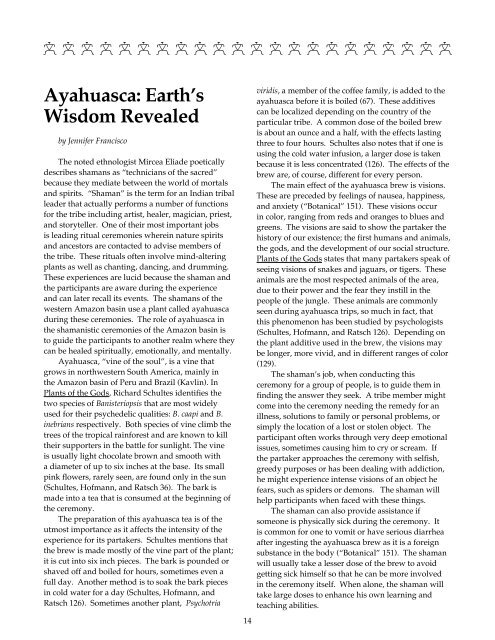A JOURNAL OF ACADEMIC WRITING VOLUME 5
A JOURNAL OF ACADEMIC WRITING VOLUME 5
A JOURNAL OF ACADEMIC WRITING VOLUME 5
Create successful ePaper yourself
Turn your PDF publications into a flip-book with our unique Google optimized e-Paper software.
d d d d d d d d d d d d d d d d d d d d d d<br />
Ayahuasca: Earth’s<br />
Wisdom Revealed<br />
by Jennifer Francisco<br />
The noted ethnologist Mircea Eliade poetically<br />
describes shamans as “technicians of the sacred”<br />
because they mediate between the world of mortals<br />
and spirits. “Shaman” is the term for an Indian tribal<br />
leader that actually performs a number of functions<br />
for the tribe including artist, healer, magician, priest,<br />
and storyteller. One of their most important jobs<br />
is leading ritual ceremonies wherein nature spirits<br />
and ancestors are contacted to advise members of<br />
the tribe. These rituals often involve mind-altering<br />
plants as well as chanting, dancing, and drumming.<br />
These experiences are lucid because the shaman and<br />
the participants are aware during the experience<br />
and can later recall its events. The shamans of the<br />
western Amazon basin use a plant called ayahuasca<br />
during these ceremonies. The role of ayahuasca in<br />
the shamanistic ceremonies of the Amazon basin is<br />
to guide the participants to another realm where they<br />
can be healed spiritually, emotionally, and mentally.<br />
Ayahuasca, “vine of the soul”, is a vine that<br />
grows in northwestern South America, mainly in<br />
the Amazon basin of Peru and Brazil (Kavlin). In<br />
Plants of the Gods, Richard Schultes identifies the<br />
two species of Banisteriopsis that are most widely<br />
used for their psychedelic qualities: B. caapi and B.<br />
inebrians respectively. Both species of vine climb the<br />
trees of the tropical rainforest and are known to kill<br />
their supporters in the battle for sunlight. The vine<br />
is usually light chocolate brown and smooth with<br />
a diameter of up to six inches at the base. Its small<br />
pink flowers, rarely seen, are found only in the sun<br />
(Schultes, Hofmann, and Ratsch 36). The bark is<br />
made into a tea that is consumed at the beginning of<br />
the ceremony.<br />
The preparation of this ayahuasca tea is of the<br />
utmost importance as it affects the intensity of the<br />
experience for its partakers. Schultes mentions that<br />
the brew is made mostly of the vine part of the plant;<br />
it is cut into six inch pieces. The bark is pounded or<br />
shaved off and boiled for hours, sometimes even a<br />
full day. Another method is to soak the bark pieces<br />
in cold water for a day (Schultes, Hofmann, and<br />
Ratsch 126). Sometimes another plant, Psychotria<br />
14<br />
viridis, a member of the coffee family, is added to the<br />
ayahuasca before it is boiled (67). These additives<br />
can be localized depending on the country of the<br />
particular tribe. A common dose of the boiled brew<br />
is about an ounce and a half, with the effects lasting<br />
three to four hours. Schultes also notes that if one is<br />
using the cold water infusion, a larger dose is taken<br />
because it is less concentrated (126). The effects of the<br />
brew are, of course, different for every person.<br />
The main effect of the ayahuasca brew is visions.<br />
These are preceded by feelings of nausea, happiness,<br />
and anxiety (“Botanical” 151). These visions occur<br />
in color, ranging from reds and oranges to blues and<br />
greens. The visions are said to show the partaker the<br />
history of our existence; the first humans and animals,<br />
the gods, and the development of our social structure.<br />
Plants of the Gods states that many partakers speak of<br />
seeing visions of snakes and jaguars, or tigers. These<br />
animals are the most respected animals of the area,<br />
due to their power and the fear they instill in the<br />
people of the jungle. These animals are commonly<br />
seen during ayahuasca trips, so much in fact, that<br />
this phenomenon has been studied by psychologists<br />
(Schultes, Hofmann, and Ratsch 126). Depending on<br />
the plant additive used in the brew, the visions may<br />
be longer, more vivid, and in different ranges of color<br />
(129).<br />
The shaman’s job, when conducting this<br />
ceremony for a group of people, is to guide them in<br />
finding the answer they seek. A tribe member might<br />
come into the ceremony needing the remedy for an<br />
illness, solutions to family or personal problems, or<br />
simply the location of a lost or stolen object. The<br />
participant often works through very deep emotional<br />
issues, sometimes causing him to cry or scream. If<br />
the partaker approaches the ceremony with selfish,<br />
greedy purposes or has been dealing with addiction,<br />
he might experience intense visions of an object he<br />
fears, such as spiders or demons. The shaman will<br />
help participants when faced with these things.<br />
The shaman can also provide assistance if<br />
someone is physically sick during the ceremony. It<br />
is common for one to vomit or have serious diarrhea<br />
after ingesting the ayahuasca brew as it is a foreign<br />
substance in the body (“Botanical” 151). The shaman<br />
will usually take a lesser dose of the brew to avoid<br />
getting sick himself so that he can be more involved<br />
in the ceremony itself. When alone, the shaman will<br />
take large doses to enhance his own learning and<br />
teaching abilities.
















